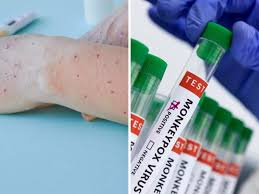monkeypox virus india
monkeypox virus , a zoonotic virus belonging to the Orthopoxvirus genus, is closely related to the variola virus that causes smallpox. Although first identified in laboratory monkeys in Denmark in 1958, the virus is primarily transmitted to humans from animals such as rodents. The disease manifests similarly to smallpox but is generally less severe. For years, monkeypox was considered endemic to certain regions of Africa, particularly in Central and West African countries. However, in 2022, monkeypox saw an unprecedented global spread, including cases reported in India, raising concerns about its public health impact.
Table of Contents
Understanding Monkeypox
Monkeypox is a viral illness that can infect both humans and animals. The virus is divided into two distinct clades: the Central African (Congo Basin) clade, which is more severe, and the West African clade, which has a lower mortality rate. Human monkeypox was first identified in 1970 in the Democratic Republic of the Congo (then Zaire), and sporadic outbreaks have occurred in Central and West Africa ever since.
The transmission of monkeypox to humans can occur through direct contact with the blood, bodily fluids, or skin lesions of infected animals. Secondary human-to-human transmission can occur through respiratory droplets, contact with contaminated materials, or close contact with infected individuals. The incubation period typically ranges from 6 to 13 days, but it can be as long as 21 days. Symptoms of monkeypox include fever, headache, muscle aches, back pain, swollen lymph nodes, chills, exhaustion, and a characteristic rash that often starts on the face before spreading to other parts of the body.

Global Spread and the 2022 Outbreak
Historically, monkeypox cases outside of Africa were rare and typically associated with international travel or the importation of animals from endemic regions. However, in May 2022, a significant outbreak of monkeypox was reported in multiple countries across Europe, North America, and other regions, many of which had no previous history of the disease. This global spread was unusual and led to widespread concern among public health authorities.
The World Health Organization (WHO) declared the outbreak a Public Health Emergency of International Concern (PHEIC) in July 2022, highlighting the need for coordinated international efforts to control the spread of the virus. The 2022 outbreak was primarily caused by the West African clade, which has a lower fatality rate but still posed significant health risks, particularly to vulnerable populations.
Monkeypox in India: The 2022 Scenario
India, with its vast population and extensive international travel links, was not immune to the global spread of monkeypox. The first confirmed case of monkeypox in India was reported on July 14, 2022, in the state of Kerala. The patient was a man who had recently returned from the United Arab Emirates (UAE). Following this, more cases were identified in other states, including Delhi and Karnataka, prompting the Indian government and health authorities to take swift action to prevent further spread.
Response and Preparedness
India’s response to the monkeypox outbreak involved a multi-pronged approach, focusing on surveillance, containment, public awareness, and vaccination. Key measures included:
- Surveillance and Screening: The Ministry of Health and Family Welfare (MoHFW) issued guidelines for the surveillance and screening of suspected monkeypox cases at international airports and seaports. Travelers arriving from affected countries were monitored, and those exhibiting symptoms were isolated and tested.
- Testing and Diagnostics: The National Institute of Virology (NIV) in Pune was designated as the central laboratory for testing monkeypox samples. The Indian Council of Medical Research (ICMR) also collaborated with state governments to set up testing facilities in multiple states, ensuring quick diagnosis and timely reporting of cases.
- Isolation and Contact Tracing: Confirmed cases of monkeypox were isolated in designated healthcare facilities to prevent the virus from spreading.
- Public Awareness Campaigns: The Indian government launched public awareness campaigns to educate citizens about monkeypox, its symptoms, modes of transmission, and preventive measures. These campaigns were crucial in reducing panic and ensuring that the public was informed about the necessary precautions.
- Vaccination: Although no specific vaccine for monkeypox was available in India at the time of the outbreak, the country leveraged its existing stockpiles of smallpox vaccines, which have shown some cross-protection against monkeypox. The government considered the possibility of targeted vaccination for high-risk groups, such as healthcare workers and close contacts of confirmed cases.
Challenges and Public Health Concerns
Despite the proactive measures taken by the Indian government, the monkeypox outbreak posed several challenges:
- Limited Vaccine Availability: India did not have a dedicated monkeypox vaccine, and the reliance on smallpox vaccines raised concerns about their efficacy and availability. Additionally, the logistics of vaccine distribution and administration in a country as large and diverse as India presented significant challenges.
- Public Health Infrastructure: The outbreak tested India’s public health infrastructure, which had already been strained by the COVID-19 pandemic. Ensuring adequate isolation facilities, laboratory capacity, and healthcare resources was crucial to managing the situation effectively.
- Stigma and Misinformation: As with many infectious diseases, monkeypox led to stigma and discrimination, particularly against individuals from affected regions or those with visible symptoms. Misinformation and rumors spread quickly, complicating public health efforts and causing unnecessary fear.
- Cross-Border Transmission: India shares borders with several countries, some of which have less robust healthcare systems. The risk of cross-border transmission required coordinated efforts with neighboring countries to prevent the virus from spreading across borders.
https://indianfastearning.com/
Conclusion
The monkeypox outbreak in India in 2022 was a significant public health challenge, but it also provided valuable lessons for the future. India’s response demonstrated the importance of preparedness, rapid response, and public cooperation in managing infectious diseases. As the world continues to grapple with emerging pathogens, the experience with monkeypox will likely inform India’s strategies for handling future outbreaks, ensuring that the country remains vigilant and resilient in the face of new public health threats.







